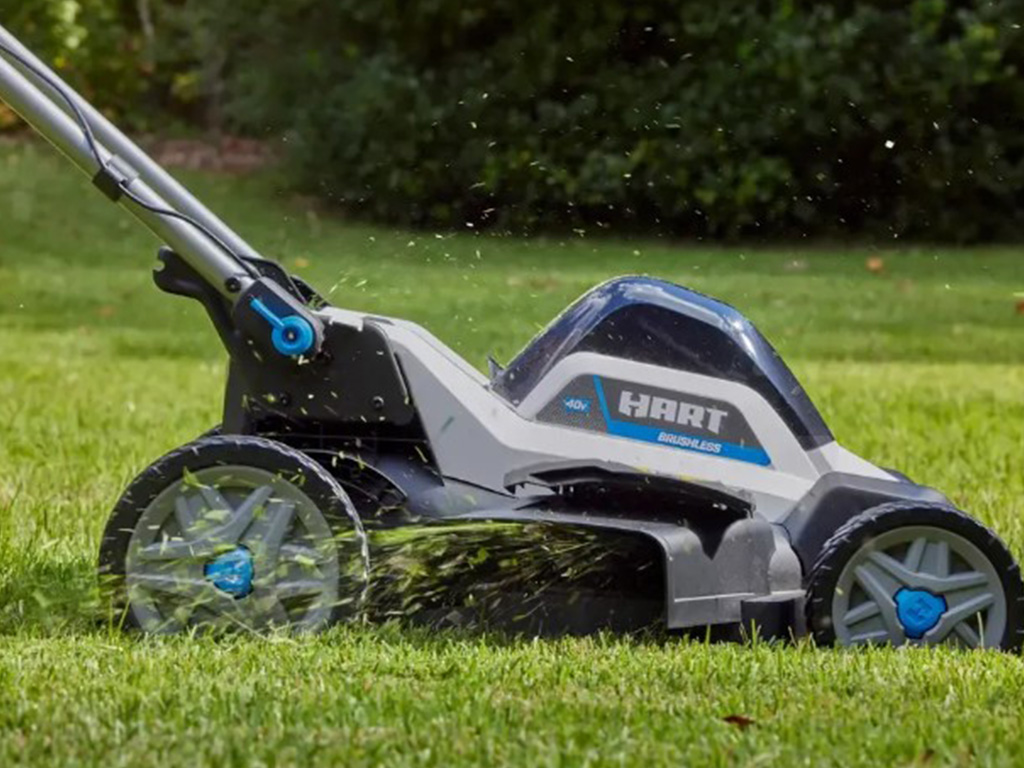A non-motorized lawn mower, also known as a manual or push mower, is a mechanical device used to trim grass. It consists of a rotating blade attached to a frame with wheels, powered by the user pushing it forward.
Non-motorized lawn mowers offer several advantages. They are environmentally friendly, producing no emissions and requiring no electricity or fuel. They are also quieter than motorized mowers, reducing noise pollution. Additionally, they are relatively inexpensive to purchase and maintain, making them a cost-effective option.
The history of non-motorized lawn mowers dates back to the 1830s, with the invention of the first manual lawn mower by Edwin Budding. Since then, non-motorized lawn mowers have evolved in design and efficiency, offering a sustainable and cost-effective alternative to motorized mowers.
Non-Motorized Lawn Mowers
Non-motorized lawn mowers offer a sustainable and cost-effective alternative to motorized mowers, with key aspects including:
- Manual power: Human-powered, requiring pushing effort.
- Silent operation: No engine noise, reducing noise pollution.
- Eco-friendly: Zero emissions, no fuel or electricity needed.
- Low maintenance: Simple design with fewer moving parts.
- Lightweight and compact: Easy to maneuver and store.
- Affordable: Typically less expensive than motorized mowers.
- Historical significance: Originating in the 1830s, a testament to innovation.
These aspects make non-motorized lawn mowers an attractive option for homeowners seeking an environmentally conscious, cost-effective, and healthy way to maintain their lawns. They are particularly well-suited for small to medium-sized lawns, as they require more effort to operate than motorized mowers. However, the physical activity involved in using a non-motorized lawn mower can also be seen as a benefit, providing a form of exercise.
Manual power
Non-motorized lawn mowers rely on manual power, meaning they are powered by the user pushing them forward. This has several implications:
- Physical exercise: Using a non-motorized lawn mower provides a form of physical exercise, as it requires the user to push the mower forward and maneuver it around the lawn.
- Effort required: Mowing a lawn with a non-motorized mower requires more effort than using a motorized mower, as the user must provide the power to rotate the blades.
- Suitable for smaller lawns: Non-motorized lawn mowers are best suited for smaller lawns, as the effort required to push the mower becomes more significant for larger lawns.
- Cost savings: Manual lawn mowers are generally less expensive to purchase and maintain than motorized mowers, as they do not require fuel or electricity.
Overall, the manual power aspect of non-motorized lawn mowers has implications for the user’s physical activity, the effort required to mow the lawn, the suitability for different lawn sizes, and the cost of ownership.
Silent operation
The silent operation of non-motorized lawn mowers is a significant advantage, as it eliminates the noise pollution associated with motorized mowers. This has several implications:
Noise reduction: Non-motorized lawn mowers produce no engine noise, significantly reducing noise pollution in residential areas. This is particularly beneficial for people living in close proximity to neighbors, as well as for wildlife and pets.
Improved quality of life: The absence of noise pollution from lawn mowing can enhance the quality of life for both the user and the surrounding community. It creates a more peaceful and tranquil environment, reducing stress and improving overall well-being.
Environmental impact: Noise pollution can have negative effects on the environment, including disrupting wildlife and contributing to habitat loss. By eliminating engine noise, non-motorized lawn mowers help to mitigate these impacts.
In summary, the silent operation of non-motorized lawn mowers is a key advantage that contributes to a more peaceful, healthy, and sustainable environment.
Eco-friendly
Non-motorized lawn mowers are inherently eco-friendly due to their lack of emissions and reliance on human power. This has several significant implications:
Environmental sustainability: Non-motorized lawn mowers contribute to environmental sustainability by eliminating air pollution and greenhouse gas emissions. They do not produce exhaust fumes or use fossil fuels, reducing the carbon footprint associated with lawn care.
Conservation of resources: By not requiring electricity or fuel, non-motorized lawn mowers help conserve natural resources. They do not contribute to the depletion of fossil fuels and reduce the demand for energy production.
Protection of ecosystems: The eco-friendly nature of non-motorized lawn mowers helps protect ecosystems and biodiversity. They do not release harmful pollutants into the air or soil, which can damage plant and animal life.
In summary, the eco-friendly aspect of non-motorized lawn mowers is a critical component of their overall sustainability. They contribute to a cleaner environment, conservation of resources, and protection of ecosystems.
Low maintenance
Non-motorized lawn mowers are characterized by their simple design and lack of complex moving parts. This has several implications for their maintenance:
Reduced maintenance needs: With fewer moving parts, non-motorized lawn mowers require less maintenance compared to motorized mowers. They do not require regular oil changes, spark plug replacements, or other engine-related maintenance.
Simplified repairs: The simple design of non-motorized lawn mowers makes them easier to repair. In the event of a breakdown, repairs can often be carried out by the user without the need for specialized tools or expertise.
Increased durability: The lack of complex moving parts contributes to the overall durability of non-motorized lawn mowers. They are less prone to breakdowns and can withstand rougher use compared to motorized mowers.
In summary, the low maintenance requirements of non-motorized lawn mowers, due to their simple design and fewer moving parts, make them a practical and cost-effective choice for lawn care.
Lightweight and compact
The lightweight and compact design of non-motorized lawn mowers contributes to their ease of use and storage, offering several advantages:
- Maneuverability: Non-motorized lawn mowers are lightweight and easy to push, allowing for greater maneuverability around obstacles, flower beds, and tight corners.
- Ease of storage: Their compact size makes them easy to store in sheds, garages, or small spaces, without taking up excessive room.
- Reduced fatigue: The lightweight design reduces fatigue during use, making lawn mowing less physically demanding.
- Accessibility: The lightweight and compact nature of non-motorized lawn mowers makes them accessible to users of all ages and abilities, including seniors and individuals with limited mobility.
These advantages make non-motorized lawn mowers a practical choice for homeowners with smaller lawns or those who prioritize ease of use and storage.
Affordable
Non-motorized lawn mowers are generally more affordable than motorized mowers, offering a cost-effective option for lawn care. This affordability is attributed to several factors:
- Lower production costs: Non-motorized lawn mowers have a simpler design and fewer components compared to motorized mowers. This reduces the manufacturing costs, making them more affordable to produce.
- No engine or electrical components: The absence of an engine or electrical components further contributes to the lower production costs of non-motorized lawn mowers. These components are typically expensive to manufacture and maintain.
- Less maintenance and repairs: Non-motorized lawn mowers require less maintenance and repairs than motorized mowers. They do not require regular oil changes, spark plug replacements, or complex repairs, which can add to the overall cost of ownership.
The affordability of non-motorized lawn mowers makes them an attractive option for homeowners on a budget or those who prioritize cost savings in their lawn care routine.
Historical significance
The historical significance of the non-motorized lawn mower, originating in the 1830s, lies in its role as a testament to human ingenuity and the evolution of lawn care practices.
- Precursor to modern lawn care: The invention of the non-motorized lawn mower marked a significant milestone in the history of lawn care. It provided a more efficient and standardized method of trimming grass, paving the way for the development of modern lawn mowers and the widespread adoption of manicured lawns.
- Simplicity and reliability: The design of the non-motorized lawn mower showcased the principles of simplicity and reliability. Its manual operation and lack of complex components made it a durable and low-maintenance tool, suitable for various lawn sizes and conditions.
- Influence on future innovations: The non-motorized lawn mower served as a foundation for subsequent innovations in lawn care equipment. Its basic operating mechanism inspired the development of motorized lawn mowers, riding mowers, and other advanced lawn care technologies.
- Cultural significance: The non-motorized lawn mower became an integral part of suburban life in the 20th century. Its presence in homes and gardens symbolized the pursuit of a well-maintained outdoor space and the importance of lawn care as a cultural practice.
In conclusion, the historical significance of the non-motorized lawn mower extends beyond its practical purpose. It represents a testament to human innovation, the evolution of lawn care practices, and the cultural significance of manicured lawns.
Tips for Using Non-Motorized Lawn Mowers
Non-motorized lawn mowers offer several advantages, including their eco-friendly nature, low maintenance requirements, and cost-effectiveness. To get the most out of your non-motorized lawn mower, here are a few tips:
Tip 1: Choose the right size mower for your lawn. The size of your lawn will determine the width of the mower you need. A wider mower will cover more ground in less time, but it may be more difficult to maneuver in tight spaces.Tip 2: Mow regularly. Mowing your lawn regularly will help to keep it healthy and prevent the grass from getting too long and difficult to cut. It’s generally recommended to mow your lawn every 1-2 weeks during the growing season.Tip 3: Mow at the correct height. The height at which you mow your lawn will affect its health and appearance. The ideal mowing height varies depending on the type of grass you have, but a good rule of thumb is to mow at a height of 2.5 to 3 inches.Tip 4: Sharpen the blade regularly. A sharp blade will cut the grass cleanly and evenly, while a dull blade will tear the grass and leave it looking ragged. Sharpen the blade of your non-motorized lawn mower every few mows to keep it in good working condition.Tip 5: Clean the mower after each use. Cleaning the mower after each use will help to prevent the buildup of grass clippings and other debris. Use a damp cloth or brush to clean the mower deck, wheels, and blade.
By following these tips, you can keep your non-motorized lawn mower in good working condition and get the most out of your lawn care routine.
In conclusion, non-motorized lawn mowers offer a sustainable, cost-effective, and healthy way to maintain your lawn. By choosing the right mower for your needs, mowing regularly, mowing at the correct height, sharpening the blade regularly, and cleaning the mower after each use, you can keep your lawn looking its best.
Conclusion
Non-motorized lawn mowers offer a sustainable, cost-effective, and healthy alternative to motorized mowers. They are environmentally friendly, as they produce zero emissions and require no electricity or fuel. They are also quieter than motorized mowers, reducing noise pollution. Additionally, they are relatively inexpensive to purchase and maintain, making them a cost-effective option.
Overall, non-motorized lawn mowers are a great choice for homeowners who are looking for an environmentally conscious, cost-effective, and healthy way to maintain their lawns.
>> Check products about Non Motorized Lawn Mower, click here…



